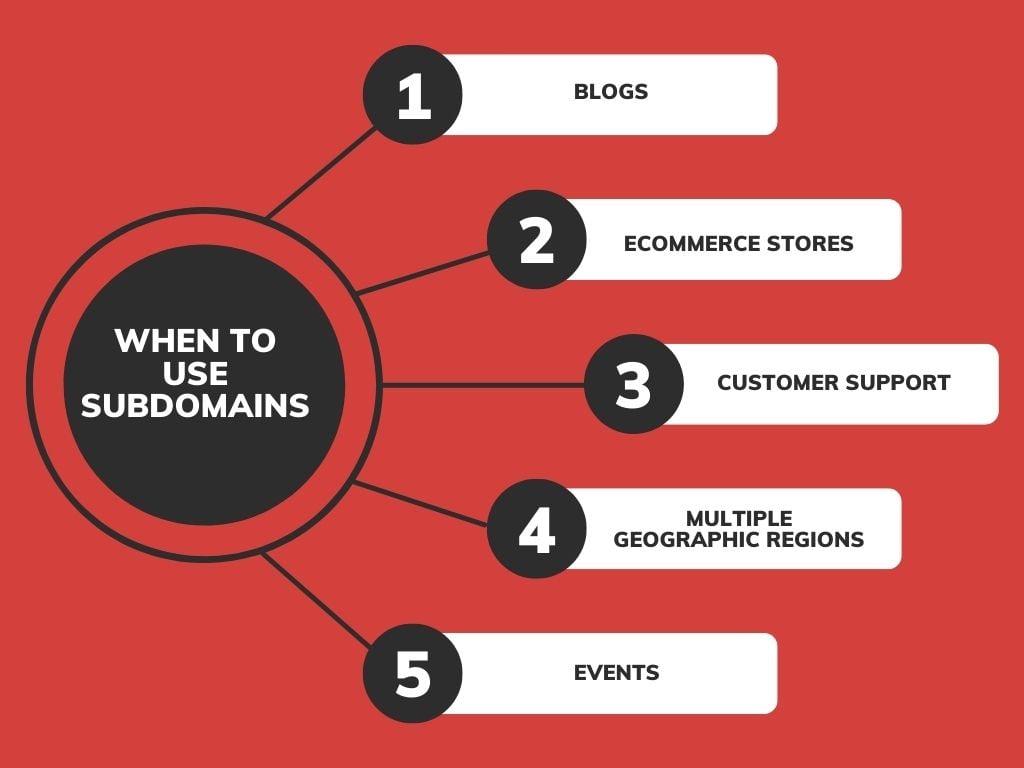Quick Links
Should you use subdomains or subdirectories to structure your website?
Which is better for your SEO?
If you’ve found yourself asking these questions recently, you’re not alone. These questions have puzzled website owners and SEOs for many years.
However, we’re here to clear up the confusion.
The truth is there are times when it makes more sense to use a subdomain, and other times when it’s better to use subdirectories.
In this in-depth guide, we’ll settle the debate once and for all. We’ll explain:
- The key differences between subdirectories and subdomains
- How each impacts your SEO
- The best use cases for both
Stay tuned to learn everything you need to know about structuring your website with subdomains and subdirectories.
What is the Difference Between a Subdomain and a Subdirectory?
Subdomains and subdirectories are both ways to structure and store the web pages and categories on your website.
Before CMS platforms like WordPress existed, site owners had to code and host websites from scratch using HTML, CSS, and JavaScript.
They needed somewhere to store the web pages they created, so they created folders to put them in, which they called subfolders or subdirectories.
It’s the same process you use whenever you want to organize files on your desktop, like creating a new folder dedicated to your vacation photos.
However, sometimes keeping track of tons of subfolders can become confusing, especially for larger websites with lots of different categories with their own sets of inner pages.
For example, some websites have online stores that have numerous inner pages for different products. Instead of storing all these web pages in a zillion subdirectories, these websites use subdomains instead.
You can think of a subdomain as a mini-website contained within your main site.
It’s still part of your site, it’s just partitioned off into a separate section to make organizing the inner pages easier. With the website’s online store on a subdomain, you’ll have a central location to manage all its inner pages (product pages, categories, etc.), making it far easier to deal with.
Once again, it all comes back to how you want to organize the web pages on your website.
Thus, the best way to understand the difference between a subdomain and a subdirectory is to imagine you have a large filing cabinet that represents your main website.
Within it are individual drawers (subdomains) and folders (subdirectories).
Subdomain
First, let’s learn more about subdomains.
Sticking with the filing cabinet analogy, a subdomain is like adding a new drawer to the cabinet.
While it’s still connected to the main cabinet, it has its own separate filing space. Inside the drawer is the subdomain’s collection of inner pages, such as the aforementioned product pages for an online store.
Besides E-commerce stores, other popular uses for subdomains include:
- Blogs
- Learning hubs (educational resources)
- The mobile version of a website
- Foreign language versions of a website (for instance, you would host the French version of your site on a separate subdomain)
What do these all have in common?
If you guessed that they all have their own sets of inner pages, you’re correct.
Take blogs, for example.
Your blog will likely have lots of posts associated with it, and may even have separate category pages. Since the pages connected to your blog are so extensive, it’s much easier to manage it on a separate subdomain instead of connecting it to your main site.
The same is true for sites offering online courses, learning hubs, and other functionalities.
For instance, The New York Times uses a subdomain (help.nytimes.com) to house its vast Help Center that contains loads of topics and FAQs.
This is helpful not only for organizational purposes but also for users, as they have a central space to seek support. If their Help Center was contained within the main site, it would be confusing and cumbersome for users to find the right FAQ or help topic.
Also, if you imagine your main website as a filing cabinet, subdomains are like separate drawers lined up side-by-side:
Understanding subdomain structure
Okay, now let’s take a look at how subdomains appear in URLs. First, let’s quickly clarify a few URL components. You can check out our guide on URL structure to learn more.
Put simply, the root domain is the main name of your website that typically appears after ‘www.’ and before ‘.com.’
For most websites, the root domain will echo their brand name, such as www.nytimes.com.
Subdomains come before the root domain, which indicates that you’re visiting a separate domain included in the main site. For example, The New York Times uses a subdomain to host all their recipes, which is:
As you can see, the ‘cooking’ subdomain comes before the root domain. This differs from subdirectories, which stem from the root domain.
For example, we don’t use subdomains at The HOTH, so our blog is included as a subdirectory. This means instead of our blog URL being:
blog.thehoth.com
It’s:
The subdirectory comes after the root domain, indicating that we’re visiting part of the main website.
Subdirectory
Going back to the filing cabinet, a subdirectory is like creating a new folder within an existing drawer. Instead of being a mini-website, a subdirectory is simply another page branching off from your main website.
This is why subdirectories are also called subfolders.
We exclusively use subdirectories on our website, such as our signup page, which is www.thehoth.com/signup. Here, the signup page is just another folder inside the main website.
With a subdirectory hierarchy, the root domain URL will always be followed by the subdirectory.
Going back to our signup page, it’s a good example of how you can use subdirectories within subdirectories. For instance, If you want to drill deeper on the signup page and become an SEO reseller, there’s another subdirectory for that: www.thehoth.com/signup/pickrole.
You can add as many subdirectories as you need until all the content you want is nested together. (Not that you should, but you can. More on why you shouldn’t drill down too deep later.)
| To sum it up:
➡️Subdomains are like separate spaces or new drawers added to your main cabinet. They can stand alone and even have their own purpose. ➡️Subdirectories are like folders within an existing space or drawer, directly connected to and part of the main content. In short, a subdomain creates a separate “drawer,” while a subdirectory creates a new “folder” within an existing cabinet drawer. Both help organize your website’s content but in slightly different ways. |
Subdomain vs Subdirectory: Which is Better for SEO?
Now it’s time to dive into the SEO side of things.
In particular, we’ll look at the debate over whether subdomains or subdirectories are best for generating traffic through search engines.
Deciding which offers the best SEO results is the biggest challenge.
This is because Google says one thing (that both are fine for SEO) while statistics say another (that subdirectories get more traffic from Google and are far better for SEO).
Many SEO experts claim that Google’s web crawlers routinely mistake subdomains for completely different websites, which is problematic for SEO, page authority, links, and so forth. Most importantly, they argue that this designation as a separate website hurts their Google page ranking.
On the other hand, Google says that, besides a slight lag time for subdomains, their crawlers index and rank subdomains in the same way they do with subfolders. In a (now famous) video, Google search advocate John Mueller states that “Google web search is fine with sites using either subdomains or subdirectories.”
 However, as pointed out by various SEO experts over the last several years, statistics show otherwise. There are dozens of examples of blogs previously hosted on subdomains being transferred to a subdirectory and, almost instantly, seeing a massive increase in organic traffic.
However, as pointed out by various SEO experts over the last several years, statistics show otherwise. There are dozens of examples of blogs previously hosted on subdomains being transferred to a subdirectory and, almost instantly, seeing a massive increase in organic traffic.
Remember how we said that our website doesn’t use any subdomains?
Yeah, that was for a reason!
We shy away from subdomains because despite what Google officially says, they treat subdomains as separate websites, which causes all sorts of issues.
Yes, in some cases, using subdomains is a better strategy.
However, subdirectories would seem to be the better choice for smaller companies with less content, smaller budgets, and few to no extensive verticals.
Why and When Should You Use a Subdomain rather than a Subdirectory (Subfolder)?
SEO reasons aside, there are times when subdomains are a necessity. As stated before, the main reason to use subdomains is to partition exclusive parts of your website that have lots of inner pages so that they’re easier to manage.
It makes the most sense to use subdomains for:
- Blogs
- E-commerce stores
- Customer support hubs
- Versions of your website in different languages
- Upcoming events
Let’s dive deeper into some of these use cases.
Distinct services separate from your main offerings
Do you offer any services that are wildly different from your main offerings?
If so, using a subdomain will help you separate them. Consider the aforementioned subdomain used by The New York Times to contain all its recipes. Since they’re normally a news source, cooking recipes are totally different from what they normally do. That’s why they chose to use a subdomain instead of a subdirectory.
You can also use the example of Amazon Web Services (AWS).
Amazon uses the subdomain aws.amazon.com for its Amazon Web Services (AWS) division.
AWS is a significant part of Amazon’s business, but it caters to a different audience (businesses and developers) compared to Amazon’s main e-commerce platform.
So, if one of your services caters to a different target audience than usual, you should consider using subdomains.
Multiple geographic regions
If your products and services appeal to multiple geographic regions, it’s wise to build a few different versions of your website in other languages.
However, you wouldn’t want to include these as subdirectories of your main site, as that would become very confusing (i.e., users may accidentally stumble into the French version of your site and won’t know how to get back).
That’s why you should use subdomains to keep each version of your site separate.
Website testing
Sometimes, site owners and developers want to test different versions of their website. It could be that they’re trying out a new visual design but don’t want to tamper with their original site.
In this scenario, they would create a staging site on a password-protected subdomain. This prevents users from viewing the staging site before it’s complete, and search engines don’t crawl or index staging sites on subdomains, which is a plus.
Technical requirements
There are times when technical requirements force your hand into using subdomains. Examples include the following:
- Different technology stacks. Subdomains provide the flexibility to host certain parts of your website on different servers or require different technologies. For instance, your main site might be on WordPress (example.com), but you need a separate subdomain for an application built on a different platform (app.example.com).
- Separate analytics and tracking. Subdomains can help when you need to track analytics separately for different parts of your website. For example, if your online store needs distinct analytics from your main site, you could use shop.example.com.
Branding
When a part of your business needs its own branding or identity, such as a subsidiary or a new product line, using a subdomain allows you to differentiate it while still linking it to the main site.
For example, the aws.amazon.com subdomain’s branding, design, and content are tailored specifically for cloud computing services, which are completely different from the retail experience on amazon.com. However, by using a subdomain, Amazon still links AWS to the main Amazon brand, benefiting from its brand recognition and trust while allowing AWS to have its distinct identity.
Large-scale projects
For large enterprises with multiple business units or departments, subdomains can help keep everything organized.
As an example, let’s go back to Amazon.
For large-scale projects, subdomains are an effective way for enterprises like Amazon to organize their various business units and departments.
Here’s what we mean:
Main site: amazon.com
Subdomains: Amazon uses subdomains for large projects like:
Human Resources
- Subdomain: Amazon.jobs
- Purpose: This subdomain is dedicated to Amazon’s career opportunities, providing a separate space for job listings, recruitment information, and HR-related content.
Amazon developer
- Subdomain: developer.amazon.com
- Purpose: This subdomain is designed for developers who want to create apps, games, or skills for Amazon devices like the Fire TV or Alexa. It provides resources, documentation, and tools for developers.
Amazon advertising
- Subdomain: advertising.amazon.com
- Purpose: Amazon uses this subdomain to manage its advertising services, in turn helping businesses to create and manage ad campaigns across Amazon’s platforms.
When To Use A Subdirectory
Let’s also take a look at when it’s best to use subdirectories.
For example, while it may be easier to host blogs on subdomains, subdirectories are better for SEO, which is why we use a subdirectory for our blog.
Other times when it makes the most sense to use a subdirectory include the following:
- SEO consolidation. If you want to strengthen the SEO of your main domain, using subdirectories allows all your content to contribute to the overall authority of the site. For example, if you have a blog, placing it in a subdirectory ensures that the SEO benefits (like backlinks and keyword rankings) apply to your main domain.
- Simplified management. Managing content in subdirectories is generally simpler because everything is housed under one domain. This makes it easier to handle updates, security, and analytics. If you’re managing multiple content sections (like a blog, store, and resources) within the same site, subdirectories are convenient.
- Related website content. If the content is closely related to your main site’s theme or topic, a subdirectory keeps everything under one roof, which can help search engines understand your site’s overall focus. For instance, if your main site is about fitness, having a subdirectory for workout plans makes sense.
- Unified brand and user experience. Subdirectories keep everything tightly integrated within your main website, ensuring a consistent brand image and user experience across all your content.
Ultimately, the best choice depends on your specific goals and requirements. Consider factors like branding, technical needs, target audience, and long-term content strategy before making a decision.
Be Cautious with Subdirectories
While using subdirectories (or subfolders) can be effective for structuring your website, overusing them isn’t ideal.
There are two main reasons for this:
- Maintaining a strong user experience
- Not confusing search engine crawlers
⚠️User experience: The best websites are easy to navigate, allowing visitors to find what they need quickly. However, too many subdirectories can complicate this, making navigation more difficult with each click. For example, overly long URL strings can confuse visitors, increasing the risk they’ll leave your site out of frustration.
⚠️Search engine crawlers: Excessive subdirectories also make it harder for search engine crawlers to find new content, as they have to dig deeper into your site. This can negatively impact your SEO, potentially losing you visitors, clients, and sales.
To avoid these issues, use subdirectories sparingly.
This will help preserve your backlinks, maintain your domain authority, and keep your URLs short and easy to manage. Plus, it ensures that the page authority you build remains closely tied to your root domain, which is crucial for high search engine rankings.
Final Thoughts on Subdomain vs. Subdirectory
For most organizations and businesses, a subdirectory hierarchy is a better choice than one based on subdomains. They provide a better user experience and have better effects on SEO (higher keyword rankings, etc.).
Subdomains still serve a very important purpose, though, especially when hosting forms, support centers, and even blogs when the goal is to rank for a different niche.
Do you have questions about website structure or how you can improve your SEO?
Our expert team is here to help, so don’t wait to book a call with one of our SEO experts today to discuss your specific needs.













